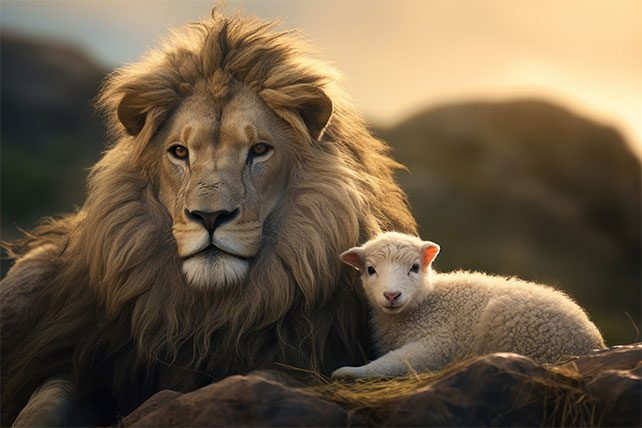The “lion and the lamb” analogy is a powerful and enduring symbol that has captivated the imagination and faith of many through the ages. It encapsulates a profound biblical metaphor that speaks of a time of ultimate peace and harmony, an era where the natural order is transformed to allow for the coexistence of once incompatible beings.
Understanding the Lion and the Lamb Analogy
While the exact phrase “lion and the lamb” isn’t found verbatim in the Bible, the concept is a synthesis of various prophetic visions presented in the scriptures, particularly in Isaiah 11:6 and Revelation 5:5-6. Isaiah envisions a peaceful kingdom where the wolf dwells with the lamb, and a little child leads them, among other harmonious pairings of natural adversaries. Meanwhile, Revelation presents Jesus Christ as both the Lion of the tribe of Judah, symbolizing his triumphant kingship, and the Lamb who was slain, representing his sacrificial death for humanity’s redemption.
This juxtaposition of strength and gentleness, sovereignty and sacrifice, captures the comprehensive nature of Jesus’ mission and character. He is the conquering King who establishes His reign of peace and justice, and the innocent Lamb who takes away the sin of the world through His sacrificial love.
The Theological Significance
In Christian theology, the lion and the lamb are emblematic of the coming age of peace and restoration. They signify the reconciliation of all creation through Christ’s atoning work, envisioning a world where enmity, predation, and violence are replaced by peace, harmony, and mutual respect among all creatures. This imagery powerfully conveys the hope of the Gospel, promising not just personal salvation but the renewal of the entire cosmos.
RELATED: 19 Famous Quotes About God’s Love
Furthermore, the lion and the lamb symbolize the dual aspects of Christ’s nature and His kingdom. He is the lion, majestic and authoritative, who will return to rule with power and justice. Simultaneously, He is the lamb, gentle and sacrificial, whose death and resurrection have opened the way to reconciliation with God. This duality emphasizes that true leadership and strength are found in self-giving love and humility.
Cultural and Artistic Expressions
The lion and the lamb metaphor has transcended religious texts to become a pervasive symbol in hymns, songs, literature, and art. It has inspired countless works that explore themes of peace, reconciliation, and the transformative power of love. In hymns such as “The Lion and The Lamb” by Big Daddy Weave, this imagery is used to worship and celebrate the comprehensive nature of Jesus’ victory and sacrifice.
In literature and art, the lion and the lamb often appear to represent the ideal of peaceful coexistence and the hope for a world freed from conflict and division. From classical paintings to modern digital art, and from ancient poetry to contemporary novels, these symbols continue to convey a deep yearning for peace and redemption.

